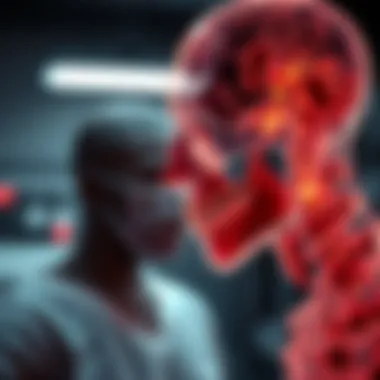Understanding Progressive Muscular Atrophy: Prognosis and Care


Intro
Progressive Muscular Atrophy (PMA) is a term that often evokes confusion and concern. This neurodegenerative disorder mainly targets motor neurons, leading to muscle weakness and atrophy. Individuals grappling with this condition find their daily lives impacted significantly, raising critical questions surrounding prognosis, symptom management, and overall quality of life. In this light, exploring PMA becomes not just an academic exercise but a necessary endeavor aimed at enhancing understanding and compassion for those affected.
The focus here will be on the multifaceted aspects of PMA, including its historical context, the scientific problems surrounding it, and the latest findings that shed light on this complex condition. By dissecting both the clinical features and the underlying mechanisms, we aim to provide a comprehensive overview that goes beyond surface-level insights. Whether you’re a student delving into neurobiology, a researcher in search of the latest developments, or a healthcare professional seeking to offer better patient care, this article is tailored for you.
In the sections that follow, we’ll take a closer look at both the historical backdrop that informs our current understanding and the nuanced discussions surrounding the prognosis of PMA.
Understanding Progressive Muscular Atrophy
Understanding Progressive Muscular Atrophy (PMA) is crucial for anyone involved in neurology, rehabilitation, and patient care. This condition, though less common than some other neurodegenerative diseases, has significant implications for those affected. To navigate its complexities, a thorough grasp of PMA's definition, epidemiology, and pathophysiology can provide insights into not only what patients experience but also how we can better support them. This knowledge serves as a beacon for professionals trying to tailor interventions and strategies that improve the quality of life for their patients. The journey through PMA isn’t just about addressing symptoms; it’s about understanding the intricacies of the disease and fostering a quality of care that aligns with patients' needs.
Definition and Overview
Progressive Muscular Atrophy is primarily marked by the degeneration of motor neurons, which are responsible for controlling various voluntary muscle movements. Unlike other forms of motor neuron diseases, PMA largely affects lower motor neurons, leading to weaknesses and muscle wasting. Patients might first notice weakness in their hands or feet, which slowly progresses to other areas of the body. This condition is often misunderstood, with many thinking of it merely as muscle weakness. In reality, the impact extends beyond muscles; it encompasses emotional and psychological challenges as individuals cope with the gradual loss of independence. That’s why understanding PMA's definition is just the tip of the iceberg.
Epidemiology
When we delve into PMA's epidemiology, we find that it has an estimated prevalence that sits between 1 to 2 per 100,000 individuals worldwide. Interestingly, it appears more frequently in men than in women. The age of onset typically ranges from the late twenties to the sixties. However, it’s worth noting that while the disease can occur in younger individuals, it mostly shows up later in life. Certain regions see higher incidences, creating an interesting puzzle for researchers trying to ascertain the underlying genetic and environmental factors contributing to this disparity. It’s essential to keep these numbers in mind as they provide a backdrop for understanding where and how PMA is most prevalent.
Pathophysiology
The pathophysiology of Progressive Muscular Atrophy is a complex web involving the degeneration of lower motor neurons in the anterior horn of the spinal cord and the brainstem. When motor neurons die, they leave behind muscle fibers that can no longer receive signals to contract. This results in progressive muscle atrophy, which can manifest in various ways depending on which muscle groups are affected. But it doesn't stop there; studies indicate that there may also be mechanisms at play involving misfolded proteins and neuroinflammation, which complicate the straightforward narrative of motor neuron death. Understanding these biological processes is of utmost importance, as they lay the groundwork for developing future therapies and interventions. Each layer of these pathological changes tells a story of a progressive decline that must be recognized and understood for effective management.
Clinical Features of Progressive Muscular Atrophy
Understanding the clinical features of progressive muscular atrophy (PMA) is essential as it lays the groundwork for recognizing the challenges faced by those affected. These characteristics not only inform the prognosis but also underline the necessity for individualized patient care. From the initial signs to the complex nature of how the disease develops, each feature offers insight into what patients endure daily.
Initial Symptoms
Identifying the initial symptoms is a critical stepping stone for diagnosis and management. In many cases, patients may first notice subtle, yet troubling, changes in their muscle strength or coordination. One hallmark of PMA is the weakness of the muscles of the hands, which can often lead to difficulties in performing everyday tasks such as turning door knobs or buttoning shirts.
Patients might describe a feeling akin to "butter fingers" as they fumble with objects. Along with this, there might be noticeable muscle atrophy not only in the hands but also in other extremities. Some individuals might experience twitching or cramps that seem to come out of the blue. These early red flags can easily be dismissed, making awareness crucial among both patients and healthcare providers.
Disease Progression
Once the initial symptoms set in, PMA tends to follow a gradual, if not painfully predictable, trajectory. As months turn into years, the condition steadily gains ground, influencing other muscle groups and expanding the scope of impairment. The onset might be slow and can vary from person to person, but many begin to notice that previously manageable tasks start becoming chores.
It's essential to note that while some may experience relatively stable periods, others might find themselves in a constant battle against functional decline. One common trajectory is the increasing difficulty with walking, which may result in a dependence on mobility aids. Interestingly, although PMA largely impacts limb muscles, it rarely affects the eye muscles or cognitive function. For many patients, this can create a stark contrast between their mental acuity and the physical limitations they experience, often leading to frustration.
Symptom Variability
Symptom variability is another intriguing aspect that sets PMA apart from other neuromuscular disorders. In one person, muscle weakness might gradually intensify, while another may experience an insidious loss of fine motor control. This unpredictability can make it challenging for clinicians to develop a one-size-fits-all treatment approach.
Furthermore, emotional changes can accompany the physical symptoms. Patients often feel a sense of loss or grief as their abilities wane, leading to varying degrees of anxiety or depression. Supporting patients through these emotional hurdles is equally important as treating the physical manifestations of the disease.
"Understanding the wide spectrum of symptoms is vital for tailoring effective management plans."
Prognostic Factors Affecting Disease Course


Understanding the factors that determine the progression of progressive muscular atrophy (PMA) is vital for tailoring individual treatment strategies and enhancing patient quality of life. These prognostic factors influence not only how quickly the disease may progress but also the effectiveness of various management techniques.
Age of Onset
Age of onset is a crucial indicator of disease trajectory. Generally, a younger individual diagnosed with PMA tends to experience a more prolonged disease course. For example, someone in their 30s might live with symptoms for decades longer compared to an individual diagnosed in their 60s. This difference can be attributed to various biological and physiological factors, including cell regeneration capabilities and overall resilience.
Each case can tell a different story. Research shows that older patients may face a steeper decline, making timely intervention critical, while younger patients may require ongoing adjustments to their care as they adapt to the progressing symptoms. Caring for younger patients often means preparing them for a road with potential long-term implications, demanding vigilance against secondary complications.
Genetic Influences
Genetic components also play a pivotal role in the course of PMA. Variants in specific genes can either predispose individuals to a more aggressive form of the disease or, conversely, confer some level of protection. For instance, mutations in the SOD1 gene are linked to familial cases of PMA and may suggest a different prognosis than sporadic occurrences. It is not just about the presence of these genes but also how they express themselves that can vary widely from one patient to another.
Research continues in the realm of genomic medicine, where understanding one’s genetic profile can help inform personalized treatment plans. Patients and healthcare providers benefit from knowing if genetic markers suggest a more benign or aggressive course, allowing for proactive approaches: adjustments in care routines, lifestyle considerations, and psychosocial support tailored to individual needs.
Comorbid Conditions
Comorbid conditions further complicate the landscape of PMA progression. Patients may experience overlapping health issues, such as respiratory disorders, cardiovascular disease, or diabetes, which can exacerbate the manifestation of PMA. A patient with existing lung issues, for example, could find their respiratory function diminishing even faster when faced with muscle atrophy affecting the diaphragm.
"The presence of comorbidities often requires an integrative treatment approach, recognizing the interconnectedness of symptoms across multiple health issues."
Understanding how these conditions interplay with muscular atrophy is crucial for a multidisciplinary care team. Thus, managing PMA effectively means considering every aspect of a patient’s health. For instance, it may involve collaborating with nutritionists to ensure an adequate caloric intake that compensates for muscle loss, physiotherapists to help maintain mobility, and mental health professionals to support emotional well-being.
In summary, the modulation of PMA progression hinges largely on various prognostic factors ranging from age of onset and genetic influences to comorbid conditions. A nuanced understanding of these elements not only aids clinicians in predicting disease course but also empowers patients with knowledge to advocate for comprehensive, personalized care.
Diagnostic Considerations
Diagnostic considerations play a pivotal role in understanding Progressive Muscular Atrophy (PMA). They encompass not only the criteria needed for accurate diagnosis but also differentiating PMA from similar disorders. Moreover, understanding these considerations is essential for developing a tailored approach to patient care, impacting treatment decisions and the overall management of the condition.
Diagnostic Criteria
The diagnostic criteria for PMA involve a thorough evaluation of clinical features and may include:
- Muscle Weakness: A hallmark symptom, usually starting in the hands or feet, which progresses over time.
- Atrophy of Muscles: Wasting of muscle seen upon physical examination.
- Exclusion of Other Conditions: Carefully ruling out other neurodegenerative diseases, creating a clear path for proper treatment plans.
To formalize a diagnosis, neurologists often deploy a combination of clinical assessments, imaging, and laboratory tests. Genetic testing can be beneficial, particularly if a hereditary component seems plausible. Accurate diagnosis hinges on the clinician's ability to knit together these threads, recognizing patterns and leading to an informed conclusion.
Differential Diagnosis
Differential diagnosis is crucial to distinguish PMA from other conditions that may mimic its symptoms. Disorders such as Amyotrophic Lateral Sclerosis (ALS), multiple system atrophy (MSA), and spinal muscular atrophy (SMA) can exhibit overlapping characteristics. The main factors that physicians evaluate during the differential diagnosis include:
- Age of Onset: PMA typically manifests later in life compared to SMA, making age an informative parameter.
- Pattern of Weakness: Analyzing the onset pattern and muscle groups affected can clarify the diagnosis.
- Progression Rate: The speed at which symptoms advance offers vital clues. PMA generally has a slower progression compared to ALS.
Careful examination of these criteria prevents misdiagnosis and equips patients and their families with a clearer picture of what lies ahead.
Role of Electromyography
Electromyography (EMG) is a critical tool in confirming PMA diagnosis. This procedure evaluates the electrical activity of muscles, providing detailed insights into nerve-to-muscle communication. EMG results can reveal:
- Denervation Patterns: Indications of ongoing muscle fiber loss, a common finding in PMA.
- Reinnervation Attempts: Identifying whether the nerves are making attempts to restore connections, which can differ from other conditions like pure lower motor neuron diseases.
Furthermore, EMG assists clinicians in ruling out other neuromuscular disorders, helping hone in on a precise diagnosis. Regular EMG tests can also track disease progression, guiding treatment modifications while providing valuable information to enhance the overall management of PMA.


Effective diagnosis is the first step toward quality management; a well-informed approach can alter the quality of life drastically for patients and families alike.
Current Research Trends
The field of progressive muscular atrophy (PMA) is evolving rapidly, with research trends illuminating new avenues for understanding and treating this complex neurodegenerative disorder. Keeping abreast of current developments is crucial for students, researchers, educators, and professionals involved in neurology and related disciplines. These research trends are not just academic exercises; they have real implications for patient care and quality of life.
Emerging Therapeutic Strategies
One of the most promising areas of research in PMA involves developing new therapeutic strategies. Traditional treatment options have often focused on symptom management, but emerging strategies aim to address the underlying mechanisms of the disease. For instance, researchers are exploring neuroprotective agents that could potentially slow disease progression. Stem cell therapy is another area of interest, with early trials suggesting it may aid in regeneration of motor neurons.
Key aspects of emerging strategies include:
- Gene Therapy: By targeting specific genetic pathways, this approach may offer hope for altering the disease's course.
- Pharmacological Developments: New medications targeting neuroinflammatory responses have shown promise in early studies.
- Combination Therapies: Using a multidrug approach could balance efficacy and safety, providing a holistic treatment path.
"The evolution of therapeutic strategies in PMA underscores the importance of personalized medicine, tailoring treatments to individual patients' genetic and symptomatic profiles."
Genetic Research Advances
Understanding the genetic underpinnings of PMA is vital for unlocking effective therapies. Recent advances in genetic research have brought to light several notable findings that may help in diagnosing and developing targeted treatments.
Significant contributions in this area include:
- Identifying Risk Factors: Research has uncovered various genetic mutations linked to PMA, enabling better risk assessments and potential preventative strategies.
- Understanding Pathways: Investigating pathways involved in neurodegeneration has opened doors for potential therapeutic targets. By isolating specific genes, scientists can explore how these mutations affect motor neuron viability.
- CRISPR Technology: This revolutionary gene-editing tool allows researchers to manipulate genes effectively, paving the way for innovative treatment solutions in clinical settings.
Clinical Trials and Outcomes
Clinical trials serve as the backbone of research in PMA. They provide critical data on the effectiveness and safety of new treatments while also examining the disease’s progression. Ongoing trials aim to address various facets of PMA, from drug efficacy to collaborative care models.
Important elements in clinical trial research include:
- Phased Approaches: Trials are systematically conducted in phases to ensure thorough evaluation before any widespread adoption.
- Outcome Measurements: Objective criteria must be used to measure treatment effects, which helps in understanding the clinical significance of findings.
- Inclusivity: Some recent trials are focusing on diverse patient populations, which allows for a broader understanding of the disease's impact across different genetic backgrounds and demographics.
Research into progressive muscular atrophy is marching forward, fueled by a commitment to unraveling its complexities to improve patient outcomes. As new therapeutic strategies emerge, genetic understandings deepen, and clinical trials adapt, the potential for impactful advancements in PMA management is more promising than ever.
Multidisciplinary Care Approach
A multidisciplinary care approach is vital in managing Progressive Muscular Atrophy (PMA). Given the complexity of the disorder and its varied manifestations, collaboration among healthcare professionals across different fields plays a key role in optimizing patient outcomes and enhancing quality of life. Each specialist contributes unique insights and strategies, making a cohesive treatment plan that meets the diverse needs of the patient.
Role of Neurologists
Neurologists are at the forefront of diagnosing and managing PMA. Their expertise enables them to accurately assess disease progression and monitor symptoms. Through careful evaluation, they guide treatment decisions, prescribing medications that may alleviate specific symptoms or slow progression. Neurologists also play a key role in coordinating care among other specialists. They provide education to patients and families about the disorder, addressing questions and concerns that arise during the treatment journey. This communication is pivotal; understanding the nature of PMA helps families navigate the challenges ahead with resilience.
Physical Therapy and Rehabilitation
Physical therapy is a cornerstone of the management plan for PMA. Physical therapists design customized exercise programs that focus on maintaining strength, flexibility, and mobility. These tailored programs are crucial since individuals with PMA often experience muscle weakness and functional decline. Therapy sessions can include specific exercises to enhance balance and coordination, helping patients maintain independence for as long as possible.
Besides exercises aimed at physical function, occupational therapy can also be beneficial. Occupational therapists review daily living activities and suggest adaptations to make them easier, thereby fostering autonomy. Additionally, the use of assistive devices, such as walkers or modified utensils, might be recommended to support everyday tasks. Adaptation is key; it can significantly enhance the overall experience for those living with PMA.
Psychosocial Support
Equally important is psychosocial support, which addresses the emotional and social challenges that accompany PMA. Patients may experience anxiety, depression, or feelings of isolation due to their condition. Thus, psychological counseling can offer invaluable support. Mental health professionals can equip patients with coping strategies, fostering resilience in facing the emotional ups and downs of the disease.


Support groups, both in-person and online, serve as additional resources for patients and caregivers. Sharing experiences in a safe space allows for mutual understanding and encouragement, which can alleviate feelings of helplessness. Engaging with others who understand the journey can be a lifeline, offering comfort when it’s needed most.
"The combined efforts of a varied team – from neurologists to physical and mental health professionals – not only target the physical aspects of PMA but also support the emotional well-being of the patient."
Living with Progressive Muscular Atrophy
Living with Progressive Muscular Atrophy can be a profound challenge for both patients and their families. This section draws attention to the multifaceted nature of PMA, highlighting the importance of understanding daily adaptations, the significance of building a robust support network, and the overall impact on quality of life. Recognizing these elements is crucial, as they can make all the difference in how individuals navigate their journey with this condition.
Adaptations for Daily Living
As PMA progresses, adapting daily living routines becomes essential. Many patients face difficulties in mobility and muscle strength, prompting the need for modifications in their environment and daily practices. Here are some common adaptations:
- Home Modifications: Installing grab bars in bathrooms, using raised toilet seats, or even chair lifts can provide stability and ease of access.
- Mobility Aids: Canes, walkers, or electric scooters may be necessary to enhance independence when moving around.
- Assistive Devices: Special utensils or adaptive kitchen tools designed specifically for grip difficulties can facilitate meal preparation and eating. Simple changes like using a stable cutting board or weighted utensils can help maintain autonomy during mealtime.
The core idea here is to foster an environment that enables individuals to perform their daily tasks with dignity. It’s about making the ordinary a bit more navigable and less daunting.
Support Networks
Having a solid support network is a linchpin in coping with PMA. Patients and families are not alone on this path. Support can come in various forms:
- Family and Friends: An emotionally supportive circle of family and friends can uplift spirits and provide practical assistance, like household chores or errands.
- Patient Support Groups: Organizations or local community groups that focus on neuromuscular diseases often form a close-knit community where sharing experiences can empower individuals and reduce feelings of isolation.
- Healthcare Professionals: Regular check-ins with a team of health specialists, including neurologists, physiotherapists, and occupational therapists, provide not only medical guidance but also emotional reassurance during difficult times.
Ultimately, the collective power of support is undeniable—having individuals who understand the challenges can significantly improve emotional and practical well-being.
Impact on Quality of Life
The quality of life for individuals with PMA is often affected by physical limitations, psychological factors, and the emotional burden associated with dealing with a progressive condition. Research emphasizes several areas where quality of life can be impacted:
- Physical Limitations: The loss of motor function gradually limits mobility, which can discourage active participation in previously enjoyed activities. This change demands mental adjustments and can lead to feelings of frustration.
- Psychological Effects: Anxiety and depression can creep in as individuals confront their realities. These emotional hurdles can strain relationships, further cascading to a diminished quality of life. Addressing mental health through therapy or counseling is important.
- Social Participation: Engagement in social activities can become challenging as routines change. Finding adaptive ways to stay involved with friends and family will help maintain connections and a sense of belonging.
"Living with PMA isn’t just about the physical ailment; it’s about facing the emotional tides that can come with it. Quality of life sparks when connections remain alive, even if they look different than before."
Future Directions in Research
As the scientific community continues to grapple with the intricacies of Progressive Muscular Atrophy (PMA), the future of research in this area holds tremendous promise. Discovering novel biomarkers, exploring innovative treatment modalities, and enhancing advocacy and awareness initiatives are essential facets critical to advancing the understanding and management of PMA. The implications of these efforts extend beyond the lab, influencing clinical practice, policy-making, and ultimately, the lives of those affected by the disease.
Novel Biomarkers
Biomarkers play a pivotal role in the diagnosis and management of neurodegenerative diseases. With PMA, identifying specific biomarkers can lead to improved diagnostic accuracy and monitoring of disease progression. Current research is honing in on proteins and genetic materials that can signal the onset of disease or indicate the severity of motor neuron degeneration.
A few promising candidates include neurofilament light chain proteins, which are released into the bloodstream as neurons are damaged. Their levels may correlate with disease severity, providing clinicians with a valuable tool for assessing progression. Moreover, investigating microRNAs could offer insight into the molecular underpinnings of PMA, leading to the discovery of biomarkers that are not only diagnostic but also prognostic.
"The search for biomarkers is not just a scientific endeavor; it is crucial for enhancing patient care and personalizing treatment strategies."
Innovative Treatment Modalities
While there is no cure for PMA, innovative treatments are being developed that aim to alleviate symptoms and improve the quality of life for patients. Research into gene therapy, for instance, is making leaps forward. By directly addressing the genetic factors contributing to motor neuron degeneration, researchers hope to tackle the root causes of PMA rather than merely managing symptoms.
Additionally, therapies targeting the inflammatory response in the nervous system are under investigation. These include immunotherapies designed to modulate the immune system's activity, potentially halting neuronal damage. Furthermore, harnessing the power of cell-based therapies, such as stem cells, is an area ripe for exploration, offering another avenue for promoting nerve repair and regeneration.
Advocacy and Awareness Initiatives
Lastly, as research progresses, the importance of advocacy and public awareness cannot be overstated. Education about PMA and its impact on individuals and families can help destigmatize the condition and encourage more people to seek diagnosis and care. Initiatives that promote understanding among healthcare providers, policymakers, and potential research participants are vital for fostering a supportive environment for both research and patient care.
Engaging with organizations dedicated to neuromuscular diseases can amplify advocacy efforts. These organizations play a key role in funding research, providing resources for patients and families, and rallying for policy changes that support better access to care.
In essence, the future of PMA research will revolve around a multifaceted approach. Combining the identification of novel biomarkers, the development of groundbreaking treatments, and proactive advocacy efforts will be paramount to improving outcomes and quality of life for those living with Progressive Muscular Atrophy.







